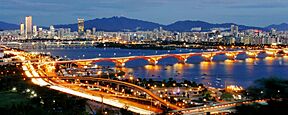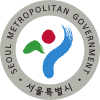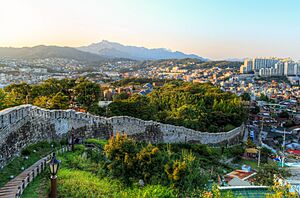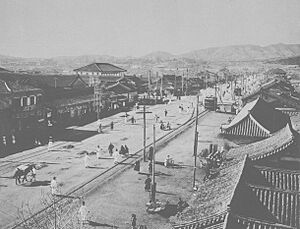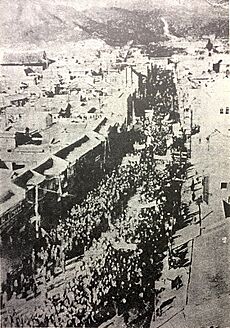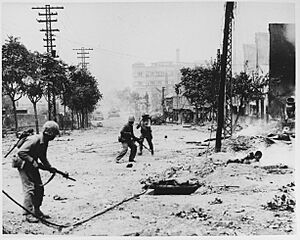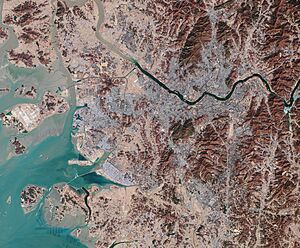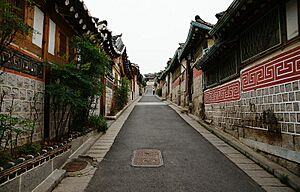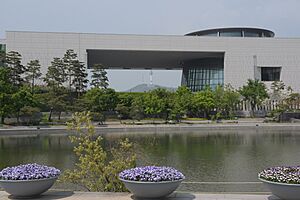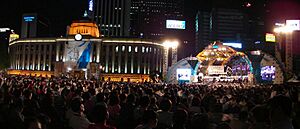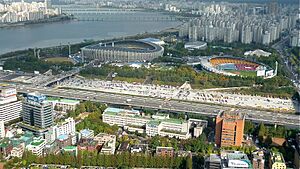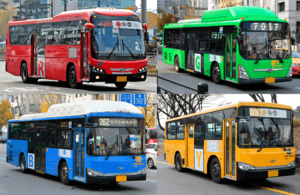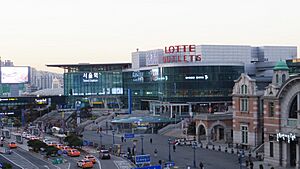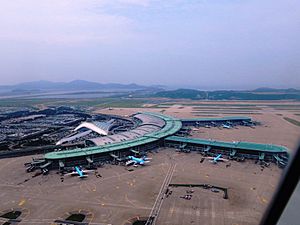Seoul facts for kids
Quick facts for kids
Seoul
서울
|
|||||
|---|---|---|---|---|---|
|
Special city
|
|||||
| Seoul Special City 서울특별시 |
|||||
| transcription(s) | |||||
| • Hangul | 서울특별시 | ||||
| • Hanja | 서울特別市 | ||||
| • Revised Romanisation | Seoul-Teukbyeolsi | ||||
| • McCune–Reischauer | Sŏul-T'ŭkpyŏlsi | ||||
|
|
|||||
|
|||||
| Motto(s):
"Seoul, my soul"
|
|||||
| Anthem: none | |||||
| Country | Republic of Korea | ||||
| Area | Seoul Capital | ||||
| Founded by | Taejo of Joseon | ||||
| Districts | 25 districts | ||||
| Government | |||||
| • Type | Mayor–council | ||||
| • Body | Seoul Metropolitan Government Seoul Metropolitan Council |
||||
| Area | |||||
| • Special city | 605.21 km2 (233.67 sq mi) | ||||
| • Metro | 12,685 km2 (4,898 sq mi) | ||||
| Elevation | 38 m (125 ft) | ||||
| Highest elevation
(Bukhan Mountain)
|
836.5 m (2,744.4 ft) | ||||
| Lowest elevation | 0 m (0 ft) | ||||
| Population
(2Q 2023)
|
|||||
| • Special city | 9,659,322 | ||||
| • Rank | 1st | ||||
| • Density | 15,960.28/km2 (41,336.9/sq mi) | ||||
| • Metro | 26,037,000 | ||||
| • Metro density | 2,053/km2 (5,320/sq mi) | ||||
| • Demonym | Seoulite | ||||
| • Dialect | Gyeonggi | ||||
| GDP | |||||
| • Special city | KR₩ 486 trillion (US$ 389 billion) |
||||
| • Metro | KR₩ 1,137 trillion (US$ 910 billion) |
||||
| Time zone | UTC+9 (Korean Standard Time) | ||||
| ISO 3166 code | KR-11 | ||||
| Bird | Korean magpie | ||||
| Color | Seoul Red | ||||
| Flower | Forsythia | ||||
| Font | Seoul fonts (Seoul Hangang and Seoul Namsan) | ||||
| Mascot | Haechi | ||||
| Tree | Ginkgo | ||||
| Seoul | |
| Hangul |
서울
|
|---|---|
| Revised Romanization | Seoul |
| McCune–Reischauer | Sŏul |
| Seoul Special City | |
| Hangul |
서울특별시
|
| Hanja |
서울特別市
|
| Revised Romanization | Seoul Teukbyeolsi |
| McCune–Reischauer | Sŏul T'ŭkpyŏlsi |
Seoul, also known as Seoul Special City, is the capital and largest city of South Korea. It's a huge city, and when you include the areas around it, like Gyeonggi province and Incheon, it's called the Seoul Capital Area. This larger area is one of the biggest economies in the world. More than half of South Korea's people live here! Even though Seoul's population has gone down a bit since 2014, it's still home to almost 10 million people. Seoul is also where the South Korean government is located.
Seoul has a long history, starting way back in 18 BC. It was founded by the people of Baekje, one of Korea's ancient kingdoms. Later, during the Joseon dynasty, it became the official capital. The city was once surrounded by a big wall called the Fortress Wall of Seoul. In the early 1900s, it was taken over by the Japanese Empire and its name was changed for a while. The Korean War caused a lot of damage to Seoul, but the city has been rebuilt and grown very quickly since then.
Seoul is known for being a great place to live in Asia. It's also a major global city for business and technology. Many big companies like Samsung, LG, and Hyundai have their main offices here. Seoul is also a popular place for big international meetings and events. It has hosted important sports events like the 1986 Asian Games, the 1988 Summer Olympics, and matches for the 2002 FIFA World Cup.
The city is surrounded by mountains and hills, with Bukhan Mountain to the north. The Seoul area has five UNESCO World Heritage Sites, which are special places recognized for their history and culture. These include beautiful palaces like Changdeok Palace and old fortresses. Seoul also has many modern buildings, like the N Seoul Tower and the Lotte World Tower. The city is a major center for music, entertainment, and culture, helping to make K-pop and the Korean Wave famous around the world.
Contents
What's in a Name? The Meaning of Seoul
The word Seoul (서울) is a native Korean word. It simply means 'capital city'. People believe it came from an older word, Seorabeol, which was the name for Gyeongju, the capital of an ancient kingdom called Silla.
Seoul has had many different names throughout history. For example, it was called Wiryeseong when it was the capital of Baekje. Later, during the Joseon dynasty, it was known as Hanseong (한성; 漢城). Even then, people often used the word seoul to talk about the capital. This is why French missionaries called the city Séoul in their writings, which led to the name we use today.
When Korea was under Japanese rule, the city was renamed Keijō (京城), which also means 'capital city'. After World War II and Korea became free, Seoul became the official name for the capital. Unlike most Korean place names, 'Seoul' doesn't have a matching Hanja (Chinese character). In Chinese, Seoul was once called Hànchéng, but in 2005, the city officially changed its Chinese name to Shǒu'ěr (simplified Chinese: 首尔; traditional Chinese: 首爾). This new name sounds like Seoul and also means 'head' or 'chief'.
Seoul's Long and Interesting History
Seoul's story began a very long time ago, around 4000 BC, when people first settled near the Han River.
From Ancient Kingdoms to a Capital City
The first recorded capital in this area was Wiryeseong, founded in 18 BC by the Baekje kingdom. There are still old city walls from this time in modern Seoul. Over centuries, different kingdoms fought for control of this important region. In the 5th century, Goguryeo took over, and then in the 6th century, Silla gained control.
In the 11th century, the Goryeo kingdom built a summer palace in Seoul. It was around this time that Seoul started to become a larger and more important settlement.
Seoul During the Joseon Dynasty
Seoul became the planned capital of Korea under Yi Seong-gye, who founded the Joseon dynasty. In 1394, he chose Hanyang (which is now Seoul) as the new capital. The city was designed following Korean traditions. Important palaces like Gyeongbokgung were built, and the Fortress Wall was started around 1396 to protect the city.
The city was divided into areas inside the wall and areas outside. The area inside the wall became the main downtown area. In the late 1800s, Seoul began to modernize. It was one of the first cities in East Asia to get electricity in the royal palace and later, electric street lights.
The Korean Empire and Japanese Rule
In 1897, Korea became the Korean Empire, and Seoul was briefly called Hwangseong, meaning 'the imperial city'. During this time, trade with countries like France and the United States helped Seoul develop. New companies were formed, bringing modern services to the city.
However, in 1910, Japan took control of Korea and renamed the city Gyeongseong (or Keijō in Japanese). The Japanese removed old city walls, paved roads, and built Western-style buildings. Seoul's special status as the capital was reduced.
Modern Seoul: Rebuilding and Growth
After World War II in 1945, Korea became free from Japanese rule. The American military helped set up the new government, and Seoul was officially named the capital. It became a "special city," meaning it was separate from other provinces.
The Korean War (1950-1953) was very tough for Seoul. The city changed hands four times between the North and South Korean forces. This fighting left Seoul mostly in ruins. Many buildings and homes were destroyed. After the war, the capital was temporarily moved to Busan.
After the war, Seoul began to rebuild and modernize very quickly. As South Korea's economy started to grow, many people moved to Seoul. In 1963, Seoul expanded its size, more than doubling its area. New bridges and expressways were built, especially in the Gangnam area, which helped it develop from a low-lying area into a modern district.
Seoul hosted the 1986 Asian Games and the 1988 Summer Olympics. It was also one of the cities for the 2002 FIFA World Cup. Today, Seoul is a major economic, political, and cultural center for South Korea. Almost half of South Korea's population lives in the Seoul metropolitan area.
Seoul's Geography and Environment
Seoul is located in the northwest part of South Korea. The city covers about 605 square kilometers (234 square miles). The Han River flows through the city, dividing it into northern and southern halves. The river is not used for boats much anymore because its mouth is near the border with North Korea.
Central Seoul has four main mountains: Bugaksan, Inwangsan, Naksan, and Namsan. The historic Fortress Wall of Seoul goes over these mountains. The city is surrounded by eight mountains in total, along with the flatter areas near the Han River.
Parks and Green Spaces
Seoul has many beautiful parks. One of the most famous is Namsan Park. It's great for hiking and offers amazing views of the city from the N Seoul Tower. Seoul Olympic Park is the largest park in the city. It was built for the 1988 Summer Olympics.
Many parks are located along the Han River, like Ichon Hangang Park and Yeouido Hangang Park. These parks are popular for exercise and relaxing. The city also has a "green belt" around it. This helps stop the city from spreading too much and gives people places to enjoy nature.
Air Quality in Seoul
Air pollution is a challenge in Seoul. The city's government keeps track of air quality and shares the information with everyone.
To improve the air, the government has put in place many rules and plans since the 1960s. A special law was passed in 2003 to improve air quality in the Seoul area. These efforts have helped reduce some types of pollution. For example, the amount of small dust particles (PM10) in the air has gone down over the years.
Air pollution in Seoul comes from different sources, including dust from Asia, local emissions from cars and factories, and emissions from China. South Korea is also working to reduce its greenhouse gas emissions.
Air Quality in the Subway
The Seoul Metro system is used by about 7 million passengers every day. In 2024, Seoul Metro announced plans to greatly improve air quality inside the subway. They plan to spend a lot of money on new air conditioning, better ventilation, and filters. They also want to replace dusty gravel tracks with concrete ones and use special mats to trap dust. They will also show real-time pollution readings to the public.
Seoul's Climate and Weather

Seoul has a climate with clear seasons. Summers are hot and humid, with a rainy season from June to September. August is the hottest month. Winters are usually cold, with temperatures often dropping below freezing. It also snows in winter, but it's generally much drier than summer. Sometimes, temperatures can get very cold, even below -15°C.
People and Education in Seoul
Seoul is a very crowded city. Its population density is almost twice that of New York City. The Seoul metropolitan area is one of the most densely populated areas in the world. As of 2021, about 9.59 million people live in Seoul. The population has been slowly decreasing since the 1990s, partly because of the high cost of living.
Many foreigners also live in Seoul. The largest group of foreigners are Chinese citizens of Korean background.
Religions in Seoul
The main religions in Seoul are Christianity and Buddhism. Other religions include traditional Korean beliefs and Confucianism. Seoul is home to one of the world's largest Christian churches, Yoido Full Gospel Church. Many people in Seoul do not follow any religion.
Education Opportunities
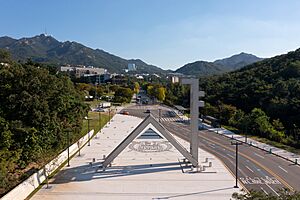
In South Korea, children go to elementary school for six years and middle school for three years. This is compulsory education. High school lasts for three years, and students usually wear uniforms. To go to university, many students take a big test called the College Scholastic Ability Test.
Seoul has many different types of schools, including science high schools and foreign language high schools. It also has many of South Korea's most famous universities, such as Seoul National University, Yonsei University, and Korea University. Seoul is considered one of the best cities in the world for students.
Seoul's Economy and Business

Seoul is the main business and financial center of South Korea. Even though it's a small part of the country's land, it holds a large percentage of South Korea's bank deposits and creates a big part of the country's total economic output. Seoul is ranked as one of the most financially competitive cities in the world.
Major Industries
Old manufacturing industries in Seoul have been replaced by new ones like information technology and electronics. However, making food and drinks, as well as printing, are still important industries. Many big companies have their main offices in Seoul, including Samsung, LG, Hyundai, and SK. Famous food and drink companies like Jinro (known for soju) and Hite (beer) are also based here.
Business and Finance Hubs
Seoul has three main business areas:
- The Downtown area: This is the historic business center, with headquarters of major companies, banks, and news agencies.
- Gangnam: Known for technology, luxury brands, and private education.
- Yeouido: Famous for stock exchanges and money management firms.
In 2023, the city announced plans to invest a lot of money to attract more foreign businesses.
Shopping and Markets
Seoul has many places to shop. The Dongdaemun Market is the largest wholesale and retail market in South Korea. Myeongdong is a popular area for shopping and entertainment, with many fashion stores. The Namdaemun Market is the oldest market in Seoul.
Insadong is a cultural art market where you can find traditional and modern Korean artworks. The Gangnam district is a very wealthy area known for its fancy shops and the COEX Mall. For electronics, the Yongsan Electronics Market is the largest in Asia. Times Square is one of Seoul's biggest shopping malls.
Technology and Connectivity
Seoul is known as one of the world's most "wired cities" because of its advanced technology. It has excellent Internet connectivity, with very fast internet speeds. Since 2015, Seoul has offered free Wi-Fi in many outdoor public places.
The city also has a modern transportation system. The KTX high-speed rail connects Seoul to other major cities. The Seoul Subway system offers 4G LTE, Wi-Fi, and DMB inside its cars.
Culture and Landmarks
Architecture and Historic Sites
The heart of Seoul is its old Joseon dynasty city center. This is where most palaces, government offices, and traditional markets are located. Cheonggyecheon is a stream that runs through the city. It was once covered but was restored in 2005, becoming a beautiful public space. Jongno street is a very old and important commercial street in the city.
Seoul has many historical and cultural landmarks. The Joseon dynasty built "Five Grand Palaces" in Seoul: Changdeokgung, Changgyeonggung, Deoksugung, Gyeongbokgung, and Gyeonghuigung. Changdeokgung is a UNESCO World Heritage site, recognized for its beautiful design. The main palace, Gyeongbokgung, has been greatly restored.
The Fortress Wall of Seoul was built to protect the city. About two-thirds of the wall still remains, along with six of the original eight gates. These include the famous south gate, Namdaemun, and the east gate, Dongdaemun. Namdaemun was the oldest wooden gate until it was damaged by fire in 2008, but it was fully restored in 2013.
Museums to Explore
Seoul has many museums, including national and city-run museums. The National Museum of Korea has a huge collection of over 220,000 historical items. The National Folk Museum of Korea shows what daily life was like for Koreans in the past. Bukchon Hanok Village and Namsangol Hanok Village are old neighborhoods with traditional Korean houses called hanok.
The War Memorial of Korea teaches about the wars Korea has been involved in, especially the Korean War. Seodaemun Prison is a former prison that is now a museum about the Japanese occupation. There are also several art museums in the city, like the Seoul Museum of Art.
Exciting Festivals
Seoul hosts many cultural festivals throughout the year. The Seoul Street Art Festival is held four times a year. It celebrates the city's 600-year history as the capital. Seoul also hosts big music festivals, like the Ultra Music Festival Korea.
Media and News
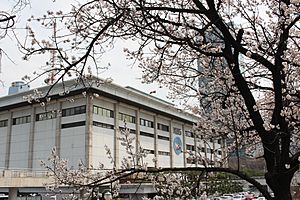
Seoul is home to South Korea's major television networks, including KBS, SBS, and MBC. It's also where the main South Korean newspapers like Chosun Ilbo and Donga Ilbo are based. International news organizations like The New York Times and The Washington Post also have offices in Seoul.
Sports in Seoul
Seoul is a big center for sports in South Korea. It has the most professional sports teams and facilities in the country. Seoul has hosted major international sports events. These include the 1986 Asian Games, the 1988 Summer Olympics, and matches for the 2002 FIFA World Cup. The Seoul World Cup Stadium hosted the opening ceremony of the 2002 World Cup.
Taekwondo is South Korea's national sport. Seoul is home to the Kukkiwon, which is the world headquarters for taekwondo.
Getting Around Seoul
Seoul has a very well-developed transportation system. It started a long time ago with the first streetcar lines and a railroad connecting Seoul to Incheon. Today, Seoul has a huge subway system and many bus lines. About 25% of the people in Seoul spend an hour or more commuting to work or school.
Bus System
Seoul's bus system is run by the city government. There are four main types of buses that cover most of the city. Seoul also has large bus terminals for buses that travel between cities across South Korea.
Subway and Urban Rail
Seoul has a huge subway system with 21 different lines. These lines connect every part of the city and the surrounding areas. More than 8 million passengers use the subway every day, making it one of the busiest in the world. The subway cars offer 4G LTE, Wi-Fi, and DMB.
Train Travel
Seoul is connected to all major cities in South Korea by train. The KTX is a high-speed train that travels over 300 kilometers per hour. Major train stations in Seoul include Seoul Station, Yongsan station, and Cheongnyangni station.
Airports for Travel
Seoul has two international airports: Incheon International Airport and Gimpo International Airport.
- Gimpo International Airport opened in 1939. It now handles domestic flights and some short international flights to nearby cities like Tokyo and Shanghai.
- Incheon International Airport opened in 2001. It handles most major international flights. It is one of the busiest airports in Asia and the world for passengers and cargo.
Both airports are connected to Seoul by expressways and the AREX train line.
Cycling in the City
Cycling is becoming more and more popular in Seoul. Both sides of the Han River have special paths for cycling that go across the whole city. In 2015, Seoul also started a bicycle-sharing system called Ddareungi (or Seoul Bike).
Seoul's Global Connections
Seoul is part of several international groups, like the Asian Network of Major Cities 21. It also hosts many embassies from countries around the world.
Sister Cities Around the World
Seoul has many sister cities, which are cities that have special friendly relationships with each other. These include:
- Taipei, Taiwan (1968)
- Ankara, Turkey (1971)
- Honolulu, United States (1976)
- San Francisco, United States (1976)
- São Paulo, Brazil (1977)
- Bogotá, Colombia (1982)
- Jakarta, Indonesia (1984)
- Tokyo, Japan (1988)
- Moscow, Russia (1991)
- Paris, France (1991)
- Mexico City, Mexico (1992)
- Beijing, China (1993)
- Ulaanbaatar, Mongolia (1995)
- Hanoi, Vietnam (1996)
- Warsaw, Poland (1996)
- Cairo, Egypt (1997)
- Rome, Italy (2000)
- Astana, Kazakhstan (2004)
- Washington, D.C., United States (2006)
- Athens, Greece (2006)
- Bangkok, Thailand (2006)
- Tashkent, Uzbekistan (2010)
See also
 In Spanish: Seúl para niños
In Spanish: Seúl para niños







